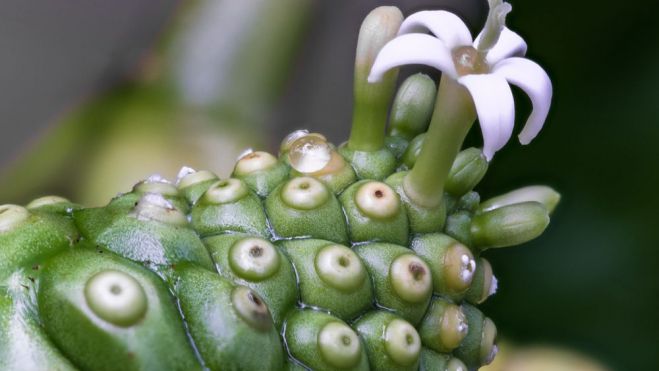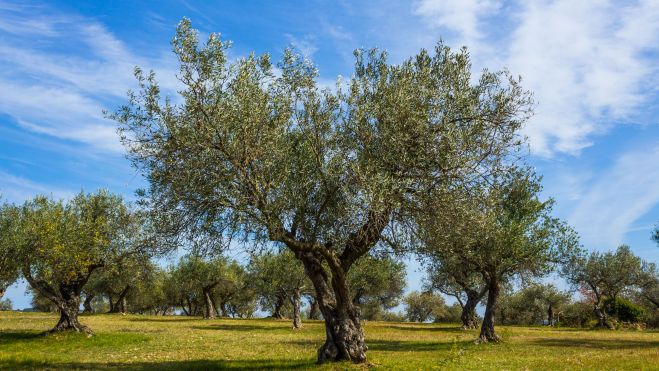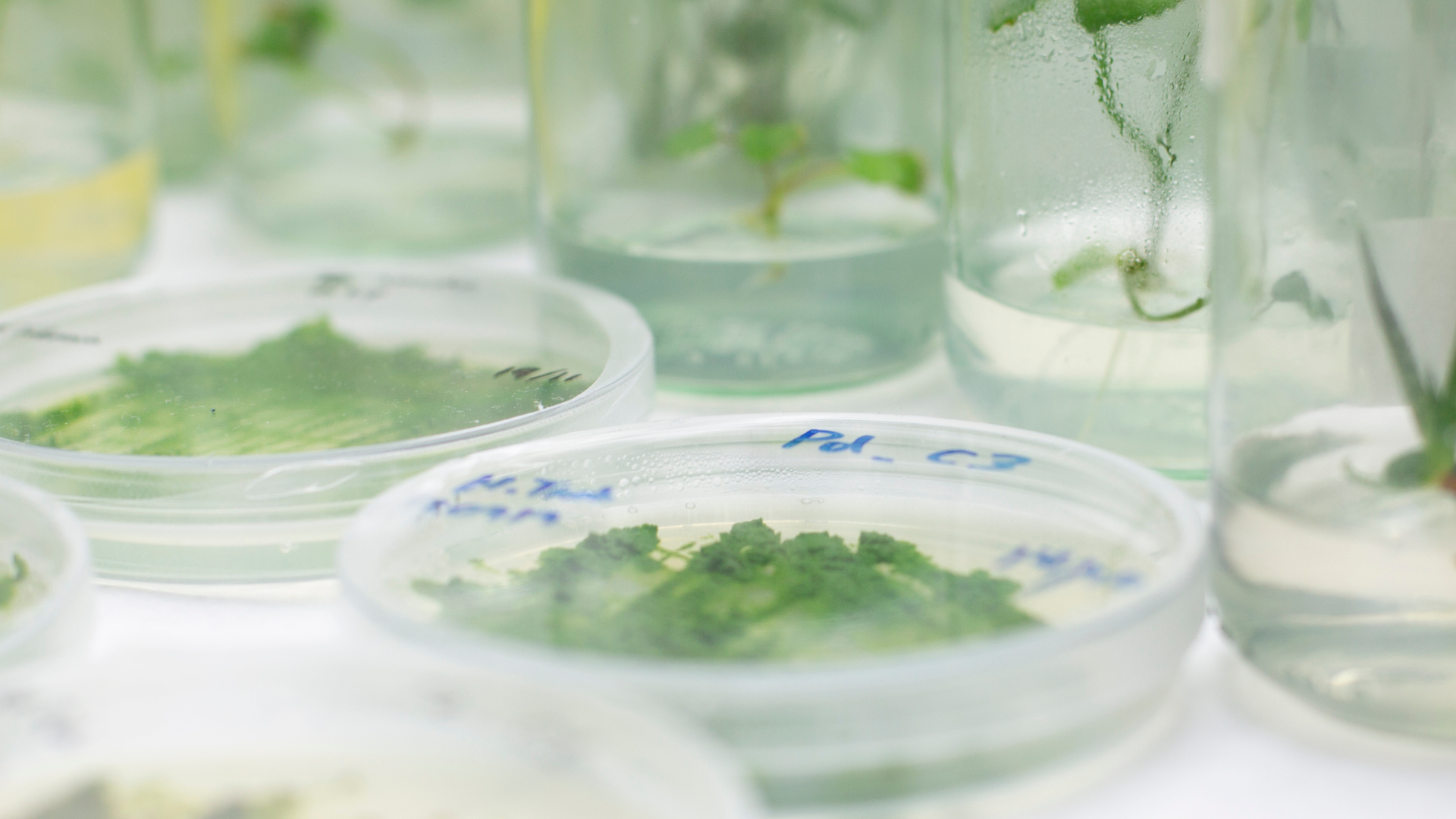Plant Stem Cells
Plants have a constant reserve of Plant Stem Cells or Totipotent cells, i.e. undifferentiated, capable of repairing any damaged tissue or regenerating a complete and functional plant from a single stem cell. In addition to their regenerative powers, they have the potential to synthesise phytocomplexes or cocktails rich in bioactive molecules specifically designed to adapt to adverse environmental situations. These active ingredients with multiple properties can be extrapolated to the development of products that care for and nourish the skin and hair in an efficient and sustainable way.
They are obtained by culturing certain precisely selected plant tissues (explants) through an engineered process of cellular reprogramming (dedifferentiation). This process is very specific and the right conditions must be found to obtain the right pool of plant stem cells in each development for each plant species (4).
An innovative biotechnological approach
Vytrus stimulates plant stem cells in its laboratory to produce very rich and specific molecular cocktails that capture the exceptional properties of plants. This nature-friendly approach avoids an impact on the plants' natural ecosystems and saves more than 99% of water consumption and 99% of arable land (calculations comparing the yield of biotechnology with the water and land required by traditional vegetable crops), while helping to preserve biodiversity (by working with plant stem cells in the laboratory, an impact on plant habitats is avoided).
Inspired by the essence of nature, Vytrus has identified different properties of plants that can be optimised through biotechnology platforms:
Adaptability: Faced with adverse environmental conditions (extreme weather, drastic climate changes, wind, lack of nutrients, etc.), plants can adapt extremely well (1-3). Using a controlled stress-response technology platform (4), it is possible to obtain defensive molecular cocktails that can protect our skin, scalp or hair.
Vitality: Plants are also able to regenerate very efficiently after damage (5,6) (regrowth of new branches, regeneration after a fire, etc.). Thanks to growth factor stimulation processes (4), it is possible to obtain natural plant peptides with excellent regenerative properties for skin, scalp and hair.
Communication: In their natural environment, plants are expert polyglots: they communicate with each other and with the organisms around them (micro-organisms, pollinators, etc.), using a wide range of molecules including, unexpectedly, sugars and lipids (7). By means of signalling lipid stimulation processes (4), it is possible to obtain plant signalling lipids with revitalising activity on the skin, scalp and hair.
Efficacy: In many specific situations, plants can use a wide variety of molecular strategies, most notably sugars, to optimise the efficiency of their biological processes (8) (use of light, water retention, signal transduction, etc.). Through biotechnology aimed at stimulating plant sugars (4), it is possible to obtain sugars that can improve the efficiency of specific processes in our skin, scalp or hair.
PRINCIPLES OF ECOLOGY, PLANT BIOTECHNOLOGY AND SKIN AND HAIR CARE
In skin and hair, there are similarities with soil and plant ecosystems. Both are stratified and require good communication between the layers, as well as maintenance of the water reservoir. Through plant biotechnology, Vytrus obtains active ingredients that respect the microbiota, correct skin imperfections and improve skin health. Similarly, in the hair, plant biotechnology offers active ingredients that prevent hair loss, strengthen, nourish and protect both hair and scalp. This technology allows us to comprehensively address the health and care of skin and hair.
Vytrus Biotech has developed two active ingredients that exemplify the conjunction of this approach: one targets the cutaneous ecosystem and the other the hair ecosystem.
- Skin ecosystem
Plant stem cells from the Morinda Citrifolia plant

Plants have developed strategies to block bacterial communication signals (Quorum Sensing) and use anti-quormonal molecules to block these signals and the damage that bacteria can cause. Applied to skin care, it is possible to avoid the formation of virulent biofilms and consequently prevent acne, pore formation and premature skin ageing.
Based on the "adaptability" of plants, Vytrus Biotech has created a 100% natural active ingredient from Noni (Morinda citrifolia) stem cells to treat acne-prone skin. It is an extremophile plant, traditionally from Polynesia, capable of colonising the basaltic rock of the volcanic islands of the Pacific, rich in anti-Quorum Sensing molecules from the Noni plant. Thanks to biotechnology, it is possible to transfer this plant mechanism to skin care to rebalance the virulent behaviour of the cutaneous microbiota: a mixture of terpenes, polyphenols and phytosterols.
- Hair ecosystem
Plant stem cells from wild olive tree (Olea Europaea)

The hair structure consists of a unit including the scalp, the follicle and the shaft (10,11). The scalp is the essential hidden part of hair biology and is responsible for the nutrition, biology and mechanical behaviour of the pilosebaceous unit. Therefore, all parts of the hair are interconnected and the entire hair system can be revitalised based on the new concept of Hair Tensegrity.
The term "tensegrity" comes from architecture and is coined from the contraction of the terms "tensional" and "integrity" (components of any structure that are under compression while being within a network in continuous tension)(12). Tensegrity explains how changes applied to one area of a given structure will also exert effects at a distance because everything is interconnected.
Therefore, if we want to optimise hair tensegrity, we must consider not only the visible part of the hair (the hair shaft), but also the scalp and the follicle, including the anchoring proteins that attach the follicle to the scalp. This biological approach makes it possible to achieve true "skinification" of the hair, revitalising the entire hair system.
Thanks to the "communication" capacity of plants and through plant biotechnology, Vytrus has developed a 100% natural active ingredient from the stem cells of the wild olive tree (Olea europaea var. sylvestris). This ancestral Mediterranean plant is characterised by its resistance, vitality and longevity. Thanks to plant stem cell technology, it has been possible to concentrate these properties in a single active ingredient for hair and scalp care. The active is rich in nourishing lipids and proteins from wild olive stem cells and uses dynamic encapsulation in cyclodextrins to facilitate the delivery of the proteolipid matrix to both hair and scalp. This results in hair and scalp that is protected from sun exposure and high temperatures, revitalised, hydrated and strengthened.
CONCLUSION
Plant stem cell technology was a niche technology that Vytrus Biotech started working with 14 years ago and is now becoming the focus of interest for the development of cosmetic formulations.
Plant biotechnology makes it possible to bring innovative concepts to the cosmetic industry and to address new metabolic pathways of the cutaneous and capillary systems with a biological approach. A solid basis for the creation of active ingredients inspired by the real power of nature, based on scientifically proven efficacy, a high degree of naturalness and the 360° sustainability that the cosmetic consumer demands for present and future cosmetics.
References:
(1) Xiao-Ping Yi et al., "Rapid recovery of photosynthetic rate following soil water deficit and re-watering in cotton plants (Gossypium herbaceum L.) is related to the stability of the photosystems", 2016, J. Plant Physiol., 194: 23-34.
(2) S. Loots Et al., "Towards better risk assessment for conservation of flowering stones: Plant density, spatial pattern and habitat preference of Lithops pseudotruncatella in Namibia", 2017, S. Afr. J. Bot., 109: 112-15.
(3) Fernández-Poyatos, M. Of the P. Et al., "Study on Three Sarcocapnos Species ace Potential Sources of Bioactive Compounds: Relation between Phenolic Content and Bioactivity by Multivariate Analysis", 2020, J. Annual. Methods Chem., 2020: 8885169.
(4) Vytrus Biotech's biotechnology platforms: Plasma-Rich in Cell Factors (PRCF) for the stress-response molecules, Phyto-Peptidic Fractions (PPF) for the natural plant peptides (growth factors), Phyto-Lipidic Fractions (PLF) for the signaling lipids, and Phyto-Glucidic Fractions (PGF) for the plant sugars.
(5) you Arrive-López, And. Et al., "To Systematic Review of the Effect of Spark asiatica on Wound Healing", 2022, Int. J. Environ. Animal. Public Health, 19(6), 3266.
(6( Tejada, S. Et al., "Wound Healing Effects of Curcumin: To Short Review", 2016, Curr. Pharm. Biotechnol., 17(11): 1002-1007.
(7) Hernández, M. L. Et al., "Differential Contribution of Endoplasmic Reticulum and Chloroplast ω-3 Fatty Acid Desaturase Genes to the Linolenic Acid Content of Olive (Olea europaea) Fruit", 2015, Plant Cell Physiol., 57(1): 138-151.
(8) Martin, C. And. Et al., "Ecophysiological function of leaf 'windows' in Lithops species – 'Living Stones' that grow underground", 2013, Plant Biol., 15(1): 243-247.
(10) Manuel Gamez-Garcia, "The Cuticle Sheath of Hair: To Functionally Graded Material", Conference: 20th International Hair Science Symposium, Dresden, Germany, September 6-8, 2017.
(11) Yang Yu, et. To the., "Structure and mechanical behaviour of human hair", 2017, Material Science and Engineering C73 152-163.
(12) Howard, B., et al., "Aging-Associated Changes in the Adult Human Skin Microbiome and the Host Factors that Affect Skin Microbiome Composition", 2022, J. Invest. Dermatol., 142: 1934-1946.

